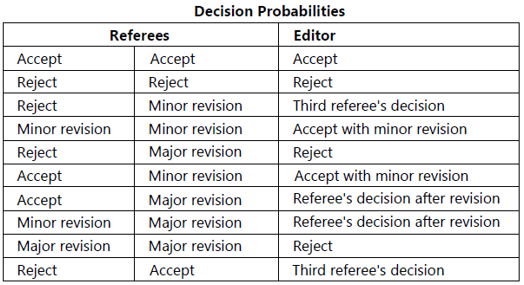Peer Review and Evaluation Process
Blind review is a method used to make sure scientific/academic publications are produced with the highest quality. This method is fundamental to the objective review of scientific studies and is preferred by many scientific journals. Reviewer views are determinant in the publication quality of EJCSRTS. All manuscripts submitted to EJCSRTS go through a double-blind review process according to the steps below:
Blind Review Method
EJCSRTS uses the double blind review method in the review process of all studies. In this method the identities of the authors and reviewers are confidential.
Initial Review Process
The studies submitted to EJCSRTS are reviewed by the editors first. At this stage, the studies which are not related with the journal's aim and scope, weak in terms of language and wording, lack originality, contain critical scientific mistakes, and do not meet the publishing criteria are rejected. The authors of such studies are informed within three weeks following the submission date. The studies deemed acceptable, on the other hand, are submitted to a field editor related with the subject of study that the work focuses on.
Pre-Review Process
In the pre-review process, the field editors evaluate the introduction and literature, method, findings, results, discussion parts of the studies in detail with respect to the publishing policies and scope of the journal as well as originality. As a result of this process, those studies that are found unacceptable are returned within three weeks the latest together with the field editor report. And the studies which are deemed appropriate are assigned to reviewers.
Assigning Reviewers
Reviewers are assigned according to the content of the studies and their subject of expertise. The field editor who reviews the study recommends three reviewers, based on their subject of expertise, from the reviewer pool of EJCSRTS or a new reviewer related with the subject of study addressed in the article. The recommendations are then evaluated by the editors and the studies are passed on to the reviewers who are obligated to guarantee that they will not share any document or details about the study they review.
Reviewer Reports
In general, the reviewer reports are based on the originality of the studies, methods, ethical considerations, consistent presentation of the findings and results and analysis of the studies with respect to literature. This evaluation is done according to the following:
- Introduction and Literature: The reviewer report includes views about the presentation and aims of the problem addressed in the study, the importance of the topic, the scope of the related literature, the originality and topicality of the study.
- Method: The reviewer report includes views about the appropriateness of the research method, sample choice and properties, validity and reliability issues, as well as data collection and data analysis.
- Findings: The reviewer report includes views about the presentation of the findings obtained through the method, the accuracy of the analysis methods, the consistency of the aims and findings of the study, the presentation of tables, diagrams and visuals that are needed, and the conceptual evaluation of the scales.
- Evaluation and Discussion: The reviewer report includes views about discussions based on findings, suitability with the research question(s) and hypothesis(ses), generalizability and applicability.
- Results and Suggestions: The reviewer report includes views about contribution to literature, recommendations for future studies and suggestions about applications in the field.
- Style and Wording: The reviewer report includes views about whether the title comprises the content of the study, whether the English language is used accurately and whether APA 7 rules are observed in giving references and in-text references in parallel with the language of the full text.
- Overall Evaluation: The reviewer report includes views about the originality of the study as a whole and the contribution it makes to the education literature and applications.
Reviewing Process
Reviewers are given 4 weeks for review. It is compulsory for the authors to complete the editing of their work within 1 month according to the rules stated in editing manual. Reviewers may ask multiple editing of a study if they deem necessary.
Review Result
The field editor evaluates the review by reviewers within 2 weeks at the latest and as a result of this evaluation the field editor informs the editors about their final decision regarding the study.

Editorial Board Decision
Based on the review done by the field editor and reviewers, editors report the views of the editorial board to the author(s) in a week at the latest along with the suggestions made by the field editor and reviewers. In this process the studies that are not accepted for publication are returned without any request for plagiarism detection. The final decision about the accepted studies is made based on the results of the plagiarism detection report. Similarity should be below 20%.
How long does the Publication Review Process last?
It is anticipated that the publication review process of the studies submitted to EJCSRTS be completed in 5 months. However, the period during which editors or reviewers ask the author(s) to do editing and the author(s) complete the editing is not included in this time frame and it is noteworthy that any unforeseen circumstance like the pandemic can be influential in the completion of the process.

